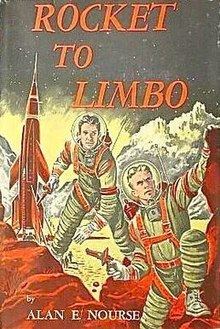Cover artist Frank Kramer Genre science-fiction novel | Language English Country United States of America | |
 | ||
Pages 198 pp (hardback edition) Published 1957 (David McKay Co., Inc.) Similar Alan E Nourse books, Other books | ||
Rocket to Limbo is a 1957 science fiction novel by Alan E. Nourse. It was first published in book form by David McKay Co., Inc, and was later incorporated into an Ace Double (with Echo in the Skull, by John Brunner). It first appeared in the October 1957 issue of Satellite Science Fiction.
Contents
Plot
On the afternoon of 2008 Mar 03 the Star Ship Argonaut lifted off Earth and set course on the Long Passage to Alpha Centauri. The builders intended that the crew establish a colony on one of Alpha Centauri's planets and then bring Argonaut back to Earth. The ship never returned and no trace of her has ever been found.
In the year 2351 Lars Heldrigsson joins the crew of the Star Ship Ganymede, which is scheduled to fly to Vega III. Once the ship has lifted herself into space Lars and the other 21 crewmen discover that the ship is actually going to the planet Wolf IV to search for the lost Star Ship Planetfall. Such a thing is unprecedented and even more disturbing is the presence of fusion bombs in the ship's hold. Angry at being effectively shanghaied onto a dangerous mission, some of the men attempt to take the ship. The mutiny fails and, threatened with abandonment in interstellar space, the mutineers agree to continue on the mission.
Wolf IV is a cold, gray planet, almost completely covered by clouds. A scout spots what appears to be the wreckage of the Planetfall lying on a mountainside and also catches a glimpse of what he takes to be a city in a valley beyond the mountains. The crew lands Ganymede on a river delta 75 miles from the wreck and landing parties go out to familiarize the men with the environment. At night the mutineers sabotage the communications equipment and return to the ship. Lars discovers the betrayal and he and the other men pursue the mutineers. When they get back to the delta they see that the ship is gone, though no one heard or saw it blast off.
With no other option available to them, the men make the arduous climb to the wreck, hoping to find food, generators to recharge the batteries in their heater suits, and possibly a means of communicating with Earth. But the wreck is not the Planetfall: it is the Argonaut. The men's last, faint hope now is to find the city that the scout thought he saw in the next valley.
The men trudge onward, over the pass, and down into the valley. The fog lifts and the men see a three-dimensional kaleidoscope, filled with people, floating several hundred feet above a meadow. Lars is taken into the city and meets up with Peter Bingham, Ganymede's other Officer-in-Training. Lars and Peter are treated as honored guests by the City-people, who possess the power of teledynamics, the ability to change the forms of matter and energy with a thought. Meanwhile Planetfall and Ganymede are kept in storage and their crews kept in deep sleep.
The City-people subject Lars and Peter to some kind of training but cannot explain what it is meant to accomplish. Then suddenly the men discover that they are being trained to develop their own teledynamic abilities and that the training has succeeded. The City-people, the descendants of the babies that aliens found in the wreck of the Argonaut, free the other men and allow them to take their ships back to Earth, with Lars and Peter as ambassadors of a new order of Reality.
At the end of the story Lars and Peter break the deadlock in the plot by developing the latent psychic powers that the City-people had been nurturing in them. In this feature the story resembles a similar breaking of the story’s deadlock found in The Angry Espers by Lloyd Biggle, Jr., in which an Earthman stranded on a strange planet must develop his latent psychic abilities in order to deal with the people around him.
Publication history
Reviews
The book was reviewed by
Listings
The book is listed at
